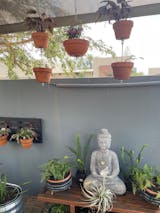
A living bouquet – keeping bulbs in containers
This week let’s talk about keeping bulbs in containers. Whether you go for a single perfect specimen in a delicate, beautiful pot placed at a focal point in your home, or a living bouquet of flowers in a huge urn to grace an outdoor space, either way you can create a show stopper.
Before I get onto the how’s and why’s of design, planting and maintenance, I should touch briefly on one drawback: container gardening does require some commitment. By their very nature, containers offer a very restricted environment where plants are totally reliant on us for regular water, nourishment and weeding. You will be disappointed if you allow your bulbs to dry out as they will probably fail to flower. Worse still, few things can be as depressing as a neglected container full of weeds or dead sticks. However, the opposite is also true: few features are as stunningly beautiful as a graceful planter overflowing with healthy and flourishing bulbs.
First a few tips on choice of container: my best advice is to go for the best you can afford. Be absolutely ruthless and chuck out any old, chipped, cracking no-longer-fresh pots you might have lying about. Toss all the scraggly leggy woody old plants on the compost heap and simplify. A jumble of messy pots and containers can be the cause of complete design indigestion – probably because we collect too many different materials with too many types of plant fillings. Less is more.
Consider overall design. Master designer, John Brooks, has this to say: “Try to stick with one material and relate that to the surface on which the objects sit.” Match classical design with classical ornamentation; use modern shapes and materials in a contemporary landscape. Outdoors, large pots are much better than small ones as they do not dry out as rapidly. Brookes continues, “This is the crunch. It is the planting that makes the pot... Whatever you do, decide upon one ‘look’ and go for it.”
Now on to some practicalities:
- Drainage is vital – very few plants will survive water logging. Make sure there is at least one hole, if not more, at the base of the container.
- Raise pots from the ground a bit – put them on ‘feet’ or concealed bricks, or just a few bits of tile.
- Start with a layer of crocks (broken pottery) or stone chips followed by a few centimetres of clean, washed river sand. This will aid free drainage but trap sand particles.
- A few chips of ordinary charcoal will keep the potting medium sweet.
- Next is the growing medium: for bulbs I favour a light, balanced mix of good garden soil and potting soil.
- A handful of bone meal will provide good nutrients, as will a dose of a good organic fertilizer.
- After planting, finish up with a layer of mulch – bark chips, fairly fine gravel or small pebbles all work well.
- As always, follow the planting guide on the packet. Plant your bulbs just as you would in the ground, at a soil depth of twice the diameter as the bulb.
- In a container, you can make a real living posy of flowers by planting bulbs very close together, almost touching.
- Add some annuals on top as ground cover – parsley and white alyssum are popular companion plants for bulbs and will not compete too much for resources.
- Go a step further and layer your bulbs. If you are working with just one variety, plant the first layer slightly more deeply than recommended, cover with soil then place a second layer in the pot – a second storey if you like. Cover with soil to slightly less than the recommended height then mulch. The deeper layer will flower a bit later than the upper storey thus extending flowering.
- If you fancy a mixed bouquet, begin by placing the biggest bulbs first, at the recommended depth, then move on in successive layers to smaller, shallower-growing ones.
- Bulbs destined for home decor should be kept outside until they flower. Return them to an outdoor nursery after flowering if you wish to keep them for more than one year.
- If you want container grown bulbs to flower in successive seasons, remember to feed them generously when planting, as they emerge from the soil, as they flower and once flowering has passed. Keep watering until the onset of dormancy.


September
20 - 21,
2025
Spring Festival
View Event


March
15 - 16,
2025
Dahlia Festival
View Event


Leave a comment